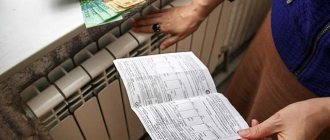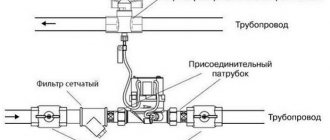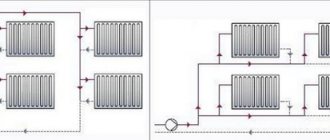Many apartment residents received large sums of money for heating. When installing the heating system, it was assumed that all the main costs would be spent at this stage. But despite this, residents receive impressive monthly bills. A new line appeared in the receipt not long ago - ONE heating. Tariffs for thermal energy increase every year, so many people think about the correctness of these calculations. You can independently calculate the thermal energy in the apartment by area.
In this article we will look at 3 examples of calculating heating in an apartment by area. In accordance with the new rules, the norms and rules of calculation have changed: payment for utilities is divided into several parts: payment for services that are provided for the general needs of the entire residential building, as well as payment for services that are provided in your individual premises. That is why the receipt indicates two heating lines.
- How is heating in an apartment calculated?
- Example 1 of calculating heating in an apartment by area
- Example 2 of calculating heating in an apartment by area
- Example 3 of calculating heating in an apartment by area
How to calculate heating charges
Everything is clear with the first two points, but you need to understand in more detail how to calculate the heating tariff:
- To find out how much they pay for heating per month, data calculated for populated areas is often used. If a meter is installed on the house, then the tariff calculation for it is carried out separately.
- Tariffs are recalculated once a year, taking into account a lot of parameters - in particular, the cost of energy resources, wage costs and average air temperature, which is taken over a five-year statistical period, are taken into account.
- When the heating season ends, the tariff is recalculated. A reduced tariff causes an additional amount to appear on the receipt, and with reduced costs, the remaining amount on the account is used to pay for the next season.
If you have a home meter, the calculation process is performed differently. At the end of the month, the management company already knows the heating costs of a particular house. Depending on the available information, the cost of heating one square meter for the billing period is calculated. Multiplying the result by the area of the apartment is the first line in the payment receipt. The second line displays the amount for heating the common area.
Why do residents of neighboring houses pay different amounts for heat?
This problem arose with the introduction of various payment methods - by quadrature (standard), by a common meter or by individual heat meters. If you looked through the previous sections of the publication, you probably noticed the difference in the monthly fee. The fact is explained quite simply: if there are measuring instruments, residents pay for the resource actually used.

Now let's list the reasons why landlords receive bills with different amounts, despite the heat meters installed in their houses:
- Heating of two neighboring buildings is carried out by different heat supply organizations, for which different tariffs are approved.
- The more apartments there are in a house, the less you can pay. Increased heat loss is observed in corner rooms and dwellings on the top floor, the rest border on the street only through 1 external wall. And such apartments are the vast majority.
- One meter at the entrance to the house is not enough. A flow regulator is required - manual or automatic. The fittings allow you to limit the supply of too hot coolant, which is a common sin for heat supply organizations. And then they charge the appropriate fee for the service.
- The competence of the management chosen by the co-owners of an apartment building plays a big role. A competent business manager will solve the issue of accounting and regulating the coolant first.
- Uneconomical use of hot water heated by coolant from a centralized network.
- Problems with metering devices from different manufacturers.
Selection of heating radiators
Traditionally, it is recommended to select the power of a heating radiator according to the area of the heated room, with a 15-20% overestimation of power requirements, just in case.
Using an example, let’s look at how correct the methodology for choosing a radiator is “10 m2 area - 1.2 kW”.

The thermal power of radiators depends on the method of their connection, which must be taken into account when calculating the heating system
Initial data: corner room on the first level of a two-story individual housing construction building; external wall made of double-row ceramic bricks; room width 3 m, length 4 m, ceiling height 3 m.
Using a simplified selection scheme, it is proposed to calculate the area of the room, we consider:
3 (width) 4 (length) = 12 m2
Those. the required power of the heating radiator with a 20% increase is 14.4 kW. Now let’s calculate the power parameters of the heating radiator based on the heat loss of the room.
In fact, the area of the room affects the loss of thermal energy less than the area of its walls, facing one side outside the building (facade).
Therefore, we will calculate exactly the area of the “street” walls present in the room:
3 (width) 3 (height) + 4 (length) 3 (height) = 21 m2
Knowing the area of the walls that transfer heat “to the street,” we will calculate the heat loss for a difference in room and street temperatures of 30° (in the house +18°C, outside -12°C), and immediately in kilowatt-hours:
0.91 21 30: 1000 = 0.57 kW,
Where: 0.91 – heat transfer resistance m2 of room walls facing “outside”; 21 – area of “street” walls; 30 – temperature difference inside and outside the house; 1000 is the number of watts in a kilowatt.

According to building standards, heating devices are located in areas of maximum heat loss. For example, radiators are installed under window openings, heat guns are installed above the entrance to the house. In corner rooms, batteries are installed on blank walls exposed to maximum exposure to winds.
It turns out that to compensate for heat loss through the façade walls of this structure, with a 30° temperature difference in the house and outside, heating with a capacity of 0.57 kWh is sufficient. Let's increase the required power by 20, even 30% - we get 0.74 kWh.
Thus, real heating power requirements may be significantly lower than the trading scheme “1.2 kW per square meter of room area.”
Moreover, correct calculation of the required power of heating radiators will reduce the volume of coolant in the heating system, which will reduce the load on the boiler and fuel costs.
Cases of application of distributor readings
Paragraph 7 of clause 42.1 of Rule 354 states: “If an apartment building is equipped with a collective (common building) heat energy meter and, at the same time, residential and non-residential premises in an apartment building, the total area of which is more than 50 percent of the total area of all residential and non-residential premises in the apartment building, equipped with distributors, the amount of payment for heating utilities is determined in accordance with the provisions of paragraphs three and four of this paragraph and is subject to adjustment once a year by the contractor in accordance with formula 6 of Appendix No. 2 to these Rules. By decision of the general meeting of owners of premises in an apartment building, members of a partnership or cooperative, a more frequent frequency during the year for adjusting the amount of payment for utility heating services provided to consumers in the apartment building specified in this paragraph may be established in the event of payment for utility services for heating during the heating season. In the event of failure, lack of indications, or evidence of a violation of the integrity of the seal of at least one distributor in a residential or non-residential premises of an apartment building, such premises are equated to premises not equipped with distributors.”
Let us note several features of this norm:
1) As indicated in the presented norm itself, it is subject to application only if the apartment building is equipped with a common house metering device (hereinafter referred to as the metering device), while distributors must be equipped with such a number of residential and non-residential premises in the apartment building, the area of which is more than 50% of the the total area of all residential and non-residential premises in the house.
2) According to the above norm, the calculation of heating fees is carried out in accordance with paragraphs 3 and 4 of clause 42.1 of Rules 354. At the same time, paragraph 3 approves the procedure for calculating the cost of heating for an apartment building in which there is a control center and none of the premises is equipped with a heating control system (this is By the way, this is one of the confirmations that the distributor and the IPU are different things, because the readings of the distributors can be used in calculations if there is no IPU in the house). Paragraph 4 approves the procedure for calculating the cost of heating for an apartment building in which there is a control center and at least one, but not all, rooms of the house are equipped with control panel. It is obvious that distributors can be used in calculations only for those premises in which there is no control unit (simultaneous equipment of the room with control unit and distributors is not provided; if there is an electrical control unit, it is the readings of the control unit that are used), including therefore for the case of the presence of control center and equipment 100 in the house % of IPU premises is not intended for use in calculating the readings of distributors.
3) The readings of the distributors are not used when calculating the cost of heating to be paid for a specific month, but exclusively when adjusting the heating fee, which is made once a year or more often if the decision on more frequent adjustments is made by the general meeting of owners or the general meeting of HOA members / housing cooperative
4) All sources of thermal energy in the room must be equipped with distributors in order for the readings of such distributors to be used in calculations. If at least one of the distributors in the room is missing or faulty (including if the integrity of the seals is broken), then the readings of the remaining distributors in such a room are not used in calculations, the room is considered not equipped with distributors.
The cost of heating services per 1 sq. m in Gcal in 2021 in an apartment building
Heating charges vary from region to region. The maximum indicators (which, of course, are in demand) are set by the regional administration, as a rule, for every six months. Plus, the formulation “heating price per 1 kW per m²” is not correct - government authorities limit the cost of the gigacalorie itself consumed by a utility unit.
After all, a gigacalorie is an analogue of a unit of work (the same Joule or kilowatt-hour), simply having a larger scale for convenience. For example:
- 1 gigacalorie corresponds to 4,184,000,000.00 Joules (4.184 gJ);
- 1 gigacalorie corresponds to 1,162.22 kilowatt-hours (kWh).
It is convenient to account for heat in gigacalories due to the large scale of thermal energy consumption (heat has an extremely high energy density compared, for example, with the same mechanical work).
These standards vary greatly among different regions due to the fact that temperature climatic regimes also differ significantly between them (winter in the Stavropol region is one thing and quite another in Anadyr). In addition, even within the same region (subject of the Federation) there may be several types of standards, depending on the quality of the house for which this standard is applied.
If this is a wooden barracks built in the 50s of the last century, then it will require more energy to maintain a comfortable temperature environment than in more modern multi-story buildings.
The standard is set specifically for 1 m² of living space, that is, there is a link: the larger your apartment, the more you will have to pay for heat if standard coefficients apply, regardless of how effective the thermal insulation is in your home.
Understanding this, the state administration seeks to create conditions and stimulate the process of equipping all consumers with individual heat meters, that is, at a minimum, to install communal heat meters.
However, there are a number of limitations:
- Now an individual metering device for an apartment (in houses built before 2012) is installed if there is a centralized supply from a single riser. If there are several pipes, then the installation of an IPU is considered physically impossible at this stage due to the need to install a large number of meters (for each battery), the high cost of the process and the complexity of accounting. Apartment buildings put into operation after 01/01/2012 (as a new building or after a major overhaul) are required by law to be equipped with individual and communal heat meters.
- Also, sometimes technical difficulties arise that make it impossible to install a common house metering device (CDMU).
In these cases, accounting is carried out in accordance with the standards. But if it is technically possible to install IPU and ODPU, and consumers still prefer to remain on the standard system of charging for heat supply, then penal increasing coefficients already begin to apply (you can learn how to decipher KPU, IPU and other abbreviations in the receipt for housing and communal services find out here).From 01/01/2017, this increasing coefficient is equal to 1.1 to the fee set by the heat supply organization. The very cost of 1 Gcal per 1 square meter in each region, of course, will be different.
Option 1
So, the house is equipped with a control device, but some rooms are left without it
Here it is necessary to take into account two positions: calculating Gcal for heating an apartment, the cost of thermal energy for general house needs (GCA)
In this case, formula No. 3 is used, which is based on the readings of the general metering device, the area of the house and the footage of the apartment.
Calculation example
Let's assume that the controller has recorded the house's heating costs at 300 Gcal/month (this information can be found from the receipt or by contacting the management company). For example, the total area of the house, which consists of the sum of the areas of all premises (residential and non-residential), is 8000 m² (you can also find out this figure from the receipt or from the management company).
Let’s take an apartment area of 70 m² (indicated in the registration certificate, rental agreement or registration certificate). The last figure on which the calculation of payment for consumed heat depends is the tariff established by the authorized bodies of the Russian Federation (indicated in the receipt or find out from the house management company). Today the heating tariff is 1,400 rubles/gcal.
Substituting the data into formula No. 3, we get the following result: 300 x 70 / 8,000 x 1,400 = 1,875 rubles.
Now you can move on to the second stage of accounting for heating costs spent on the general needs of the house. Here you will need two formulas: searching for the volume of service (No. 14) and payment for the consumption of gigacalories in rubles (No. 10).
For example, we have a total area of 7000 m² (including apartments, offices, retail premises.).
Let's start calculating the payment for thermal energy consumption using formula No. 14: 300 x (1 – 7,000 / 8,000) x 70 / 7,000 = 0.375 Gcal.
Using formula No. 10, we get: 0.375 x 1,400 = 525, where:
- 0.375 – volume of service for heat supply;
- 1400 rub. – tariff;
- 525 rub. - amount of payment.
We sum up the results (1875 + 525) and find out that the payment for heat consumption will be 2350 rubles.
Accurate heat load calculations
Thermal conductivity value and heat transfer resistance for building materials
But still, this calculation of the optimal heat load for heating does not provide the required calculation accuracy. It does not take into account the most important parameter - the characteristics of the building. The main one is the heat transfer resistance of the material used to manufacture individual elements of the house - walls, windows, ceilings and floors. They determine the degree of conservation of thermal energy received from the coolant of the heating system.
What is heat transfer resistance (R)? This is the reciprocal of thermal conductivity (λ) - the ability of the material structure to transmit thermal energy. Those. the higher the thermal conductivity value, the higher the heat losses. This value cannot be used to calculate the annual heating load, since it does not take into account the thickness of the material (d). Therefore, experts use the heat transfer resistance parameter, which is calculated using the following formula:
Calculation of walls and windows
Heat transfer resistance of walls of residential buildings
There are standardized values for the heat transfer resistance of walls, which directly depend on the region where the house is located.
In contrast to the enlarged calculation of the heating load, you first need to calculate the heat transfer resistance for the external walls, windows, ground floor floor and attic. Let's take the following characteristics of the house as a basis:
- Wall area – 280 m². It includes windows - 40 m²;
- The material used for making the walls is solid brick (λ=0.56). The thickness of the external walls is 0.36 m. Based on this, we calculate the TV transmission resistance - R = 0.36/0.56 = 0.64 m²*C/W;
- To improve the thermal insulation properties, external insulation was installed - polystyrene foam 100 mm thick. For him λ=0.036. Accordingly, R=0.1/0.036= 2.72 m²*C/W;
- The overall R value for external walls is 0.64 + 2.72 = 3.36 which is a very good indicator of the thermal insulation of a house;
- The heat transfer resistance of windows is 0.75 m²*C/W (double glazing filled with argon).
In fact, heat losses through the walls will be:
(1/3.36)*240+(1/0.75)*40= 124 W at a temperature difference of 1°C
We will take the same temperature indicators as for the aggregate calculation of the heating load +22°C indoors and -15°C outdoors. Further calculations must be made using the following formula:
Ventilation calculation
Then it is necessary to calculate the losses through ventilation. The total air volume in the building is 480 m³. Moreover, its density is approximately 1.24 kg/m³. Those. its mass is 595 kg. On average, air is renewed five times per day (24 hours). In this case, to calculate the maximum hourly heating load, you need to calculate the heat losses for ventilation:
(480*40*5)/24= 4000 kJ or 1.11 kW/hour
By summing up all the obtained indicators, you can find the total heat loss of the house:
This way the exact maximum heating load is determined. The resulting value directly depends on the outside temperature. Therefore, to calculate the annual load on the heating system, changing weather conditions must be taken into account. If the average temperature during the heating season is -7°C, then the total heating load will be equal to:
(124*(22+7)+((480*(22+7)*5)/24))/3600)*24*150(heating season days)=15843 kW
By changing the temperature values, you can make an accurate calculation of the heat load for any heating system.
To the results obtained, you need to add the value of heat losses through the roof and floor. This can be done by a correction factor of 1.2 - 6.07 * 1.2 = 7.3 kW/h.
The resulting value indicates the actual energy costs during system operation. There are several ways to regulate the heating load. The most effective of them is reducing the temperature in rooms where there is no constant presence of residents. This can be done using thermostats and installed temperature sensors. But at the same time, a two-pipe heating system must be installed in the building.
To calculate the exact value of heat losses, you can use the specialized Valtec program. The video shows an example of working with it.
Anatoly Konevetsky, Crimea, Yalta
Anatoly Konevetsky, Crimea, Yalta
Dear Olga! Sorry to contact you again. According to your formulas, I get an unimaginable heat load: Kir=0.01*(2*9.8*21.6*(1-0.83)+12.25)=0.84 Qot=1.626* 25600*0.37*((22-(-6))*1.84*0.000001=0.793 Gcal/hour According to the aggregated formula given above, it turns out to be only 0.149 Gcal/hour. I can’t understand what’s the matter? Please explain! Sorry for disturbing you. Anatoly.
Anatoly Konevetsky, Crimea, Yalta
VS told how much to pay for heat if there is no meter
A dispute between MOEK and one housing cooperative reached the Supreme Court, arguing over how much to pay for heating without a meter. The calculation standard in Moscow is known, but as a result of a legal gap, it is not entirely clear how to calculate it for a certain period. You can use one of the two coefficients, but the difference in the result will be 70%. There should be only one correct option, so that one side does not get rich and the other does not suffer losses. The Economic Board of the Supreme Court made a choice and justified it.
How much should management companies (MCs) pay for heat if the house does not have a common house meter, the Supreme Court decided in one of its recent cases. The Moscow standard is known - 0.016 Gcal/sq.m. m per month, but there is still debate whether it is calculated for the whole year (12 months) or only for the heating season (7 months). The calculation procedure has caused confusion: in the capital, residents pay equally for heat throughout the year, according to Moscow Government Decree No. 468-PP dated September 10, 2012, and the Moscow United Energy Company (MOEK) issues management bills only during the heating season.
There were two points of view on how to calculate consumption:
If the standard is annual, it must be multiplied by 12 months a year (this option is supported by a reference to Moscow government decree No. 468-PP dated September 10, 2012, which simultaneously sets the standard for the month and states that the calculation must be made evenly over of the year). In this case, per year it turns out to be 0.192 Gcal/sq. m;
If the standard is seasonal, it should be multiplied by 7 cold months and divided by 12 (this option is supported by Government Decree No. 468-PP of September 10, 2012, which prescribes dividing the number of months of the heating period by 12 months). The annual output is 0.112 Gcal/sq. m.
According to Sergei Sergeev from the Arbat MCA, judicial practice was tilted in one direction or the other, until the Moscow Government Resolution No. 435 of July 14, 2015 was issued, which “legitimized” the ratio of 12/7. But no one explained how to calculate consumption until this day. That’s why a dispute arose between MOEK and the Privet housing cooperative about how much heating cost in 2012–2013. The energy company demanded 1.4 million rubles from the cooperative. debt, not counting interest on the use of money. The cooperative objected to the use of the 12/7 odds. The courts were divided in opinion in case No. A40-170280/2013. At the last round of consideration of the case, the Moscow Arbitration Court considered the standard to be seasonal, which means that a coefficient of 7/12 should have been applied. The Arbitration Court of the Moscow District agreed with this. The Supreme Court corrected them.
0.192 or 0.112 Gcal/sq. m
How much will the management company pay? This is the price of the issue in the dispute.
He referred to his own definition of APG16–19 from April 2016, when the legality of establishing the standard was checked. Then the Supreme Court stated that the standard was approved based on annual rather than seasonal consumption. This was done to ensure that the population paid evenly and their expenses did not increase significantly during the heating season. And since residents pay the management company all year, but it only pays for seven months, it is imperative to apply the 12/7 ratio - without it, an underpayment results, explained the Supreme Court board chaired by Ekaterina Kornelyuk. As a result, the panel upheld the decision of the 9th AAS, which made a decision in favor of the energy company.
Now there are many judicial acts that have entered into legal force with opposite conclusions, Sergeev reports. He assumes that MOEK will go to appeal the lost cases: “For it, the question now is to minimize the losses already received.” In general, the definition of the Armed Forces suggests that when applying standards, you need to clearly understand for what period they were established, analyzes Sergeev.
Deputy head of the judicial protection department of the Arbat MCA, Yuri Netreba, predicts a continuation of the “struggle for the wording” of the application of the 12/7 coefficient. After all, the figure for calculating the standard is 0.016 Gcal per square meter. m., of course, already took into account seasonality and the need to maintain networks during the unheated period, the expert notes.
- Housing and communal services, Courts and judges
- Arbitration Court of Moscow, 9th Arbitration Court of Appeal, Collegium of the Supreme Court for Economic Disputes
Apartment-by-apartment and general-house standards for utility consumption
Let's look at what the thermal energy consumption standard is and how it is calculated. The procedure for calculating and setting heating standards is regulated by Government Decree No. 306. General provisions and formulas for calculating heat supply, taking into account the presence or absence of metering devices, are established by Government Decree No. 354.
According to clause 10 of PP No. 306, standards are established in relation to individual consumption of utilities and maintenance of the common property of an apartment building. Owners who have not installed meters pay for heating according to standards that involve calculating the average rate of heat energy consumption.
The calculation formula takes into account the following features:
- the presence of a common house meter (read more about heat meters for heating here);
- number of installed individual metering devices;
- billing period: 12 calendar months or according to the heating season schedule.
The standards are established by regional regulations and, as of 2021, apply to apartment buildings that do not have individual or communal meters installed. If a house has a communal meter installed, but no individual meters are installed, then the calculation is made in accordance with its indicators. Owners with private ownership pay for heating according to individual requirements.
Important! Based on PP No. 603, increasing coefficients are not applied to consumers who have not installed IPU in residential premises when calculating heating fees.
There are also separate rules that regulate the commercial metering of thermal energy and coolant. This document describes in detail the requirements for individual investment management, accounting methods, and much more.
Who installs them?
Based on clause 9 of PP No. 306, average standards for thermal energy consumption per 1 sq. m has the right to establish:
- regional executive authorities;
- resource supply organizations;
- management companies;
- housing cooperatives;
- partnership.
The establishment of standards at the initiative of the management company or resource supplying organization is carried out on the basis of a collective application to the authorized body and is considered within 30 days.
Calculation of the number of batteries per 1 sq. m
The area of each room where radiators will be installed can be viewed in the real estate documents or measured independently. The heat requirement for each room can be found in building codes, which state that to heat 1m2 in a certain residential area you will need:
- for harsh climatic conditions (temperatures below -60 degrees) – 150-200 W;
- for the middle band - 60-100 W.
To calculate, you need to multiply the area (P) by the heat demand value. Taking these data into account, as an example, we present a calculation for the climate of the middle zone. To sufficiently heat a room of 16 square meters. m, you need to apply the calculation:
16 x 100 = 1600 W
Next, the number of battery sections (N) is calculated - the resulting value is divided by the heat generated by one section. It is assumed that one section emits 170 W, based on this, the calculation is carried out:
It’s better to round up – 10 pieces. But for some rooms it makes more sense to round down, for example, for the kitchen, which has additional heat sources. Then there will be 9 sections.
Calculations can be carried out using another formula, which is similar to the calculations presented above:
- N – number of sections;
- S – room area;
- P – heat transfer of one section.
So, N = 16 / 170 * 100, hence N = 9.4.
Why do we pay for heat supply in EPD in summer?
The Unified Payment Document (UPD) contains accounts for various sectors of the housing sector, including utility costs for the use of heat in the summer. Tenants justifiably have a question: why do I pay for heat supply in the summer, while the heating season is within autumn-spring.
The legislation of the Russian Federation allows for the collection of payments for heat supply in two ways:
- in equal monthly installments;
- only in winter.
Most often, management companies use the first method, since it allows the monthly payment amount to be “spread out” evenly. When accrued using the second method, the costs of the home budget during the heating season will increase significantly, and the rest of the time will not be charged.
You cannot blindly trust the amounts written on the receipt. If there are any doubts about the integrity of housing and communal services representatives, it is best to make independent simple calculations using a calculator using the above calculation methods. If a discrepancy is identified, contact the utility company with a request to issue an invoice again.
Calculation
The procedure for calculating the heating bill will depend entirely on how the house is heated and what heating devices are installed in the room. There are several basic options for equipping a home with devices and appliances, which largely determine how heating in an apartment is calculated:
- In a residential building, only one device is installed, which is common, and in apartments and non-residential premises there are no metering devices at all.
- The house has a common device, which is needed to account for heating, but also individual rooms in the house are equipped with individual devices.
- The house completely lacks a common heating meter.
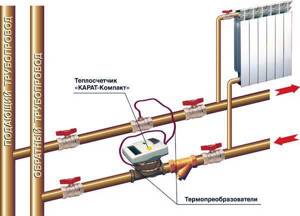
. First of all, you need to find out if there is one common household device installed in the house, and also whether there are other individual heating metering devices in residential or non-residential premises.
How is heat calculated?
The calculation consists of the following steps.
Stage 1
. “Reconnaissance” regarding heat loss in the apartment. This will be required in order to correctly determine the power of the boiler and heating devices. Such heat losses must be calculated individually for each room that has an external wall.
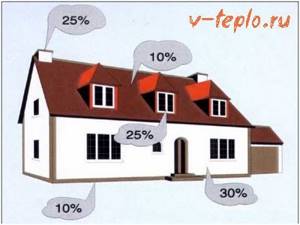
Stage 2
. We select the optimal temperature regime. International heating standards EN-442 provide the following parameters: 20-65-75 degrees (room-heating appliances-boiler).
Stage 3
. We determine the power of the batteries based on the data obtained regarding heat loss in the apartment.
Stage 4
. We make hydraulic calculations, without which the heating system will be ineffective. With its help, the parameters of the circulation pump are determined, as well as the diameter of the pipes.
Stage 5
. Determine the power of the heating boiler.
Stage 6
, it is also final. The volumes of the heating system are measured. There are a lot of online calculators for this on the Internet, so we won’t dwell on this.
Calculation of the payment amount for individual meters with an additional amount for the house
Calculation of the cost of heat in the presence of an individual and communal heating meter is carried out not only if all non-residential and residential premises in the house are equipped with individual meters, but also if there are only common devices for a separate apartment.
In this case, the cost of heat per apartment is calculated as the sum of the energy that was used according to individual devices and general house consumption.
Its cost is distributed proportionally among all apartments. All actions and tariffs are regulated by formula No. 3 (1), Appendix No. 2 of Resolution No. 344, where:
- the total volume of heat used according to an individual meter;
- the amount of heat that was expended exclusively for heating the non-residential premises of the entire house is calculated as the difference between the sum of all individual indicators and a single one - the general one;
- the entire area of the apartment (with one individual meter);
- the area of all heated rooms in the house.
Initial data for thermal calculation of the heating system
Before you begin to calculate and work with data, you need to obtain it. Here, for those owners of country houses who have not previously been involved in design activities, the first problem arises - what characteristics are worth paying attention to. For your convenience, they are summarized in a short list below.
- Building area, ceiling height and internal volume.
- Type of building, presence of adjacent buildings.
- Materials used in the construction of the building - what and how the floor, walls and roof are made of.
- The number of windows and doors, how they are equipped, how well they are insulated.
- For what purposes will these or those parts of the building be used - where the kitchen, bathroom, living room, bedrooms will be located, and where - non-residential and technical premises.
- Duration of the heating season, average minimum temperature during this period.
- “Wind rose”, the presence of other buildings nearby.
- An area where a house has already been built or is about to be built.
- Preferred temperature for residents in certain rooms.
- Location of points for connecting to water supply, gas and electricity.

Heat loss in the house

Thermal insulation measures shown in the image above will help to significantly reduce the amount of energy and coolant required to heat a residential building




